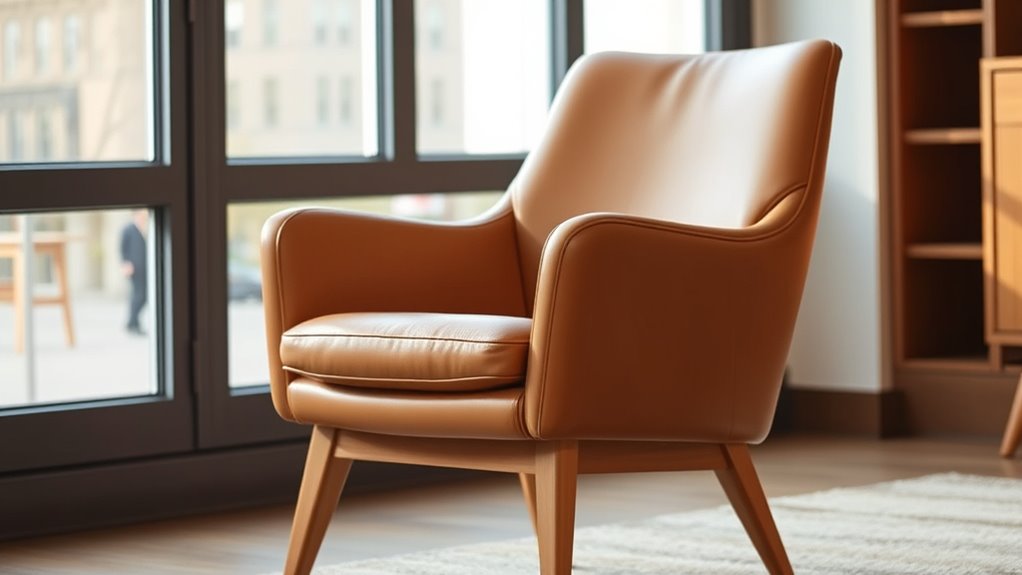To make standing up easier, look for seating with ergonomic features like adjustable height, lumbar support, and a design that encourages good posture. Chairs with flexible cushions, sturdy frames, and options for customizing height and tilt can reduce strain and improve mobility. Lift chairs or stools with supportive materials help you shift seamlessly from sitting to standing. Keep exploring to find the perfect supportive seat tailored to your needs and comfort.
Key Takeaways
- Choose height-adjustable chairs or stools to match user height and facilitate effortless standing.
- Opt for seats with supportive cushions, like memory foam, to reduce pressure and improve ease of rising.
- Select chairs with ergonomic features such as lumbar support and posture-promoting designs.
- Use lift chairs or seats with built-in assistance mechanisms to aid users with mobility challenges.
- Prioritize durable, supportive materials and reinforced frames for stability during transitions.
Ergonomic Features That Facilitate Standing Up

When choosing a chair that makes standing up easier, ergonomic features play a crucial role. Look for models with height adjustability, allowing you to set the seat at an ideal level to reduce strain when shifting from sitting to standing. Proper height adjustment ensures your feet are flat on the floor and your knees are at a comfortable angle, making it easier to rise smoothly. Additionally, good lumbar support offers consistent back comfort, encouraging proper posture and reducing fatigue. When your lower back is well-supported, you’re less likely to slump or strain during movement. These ergonomic features work together to promote better posture and make standing up less effortful, supporting your mobility and comfort throughout the day.
Types of Seating Designed for Easy Transitions
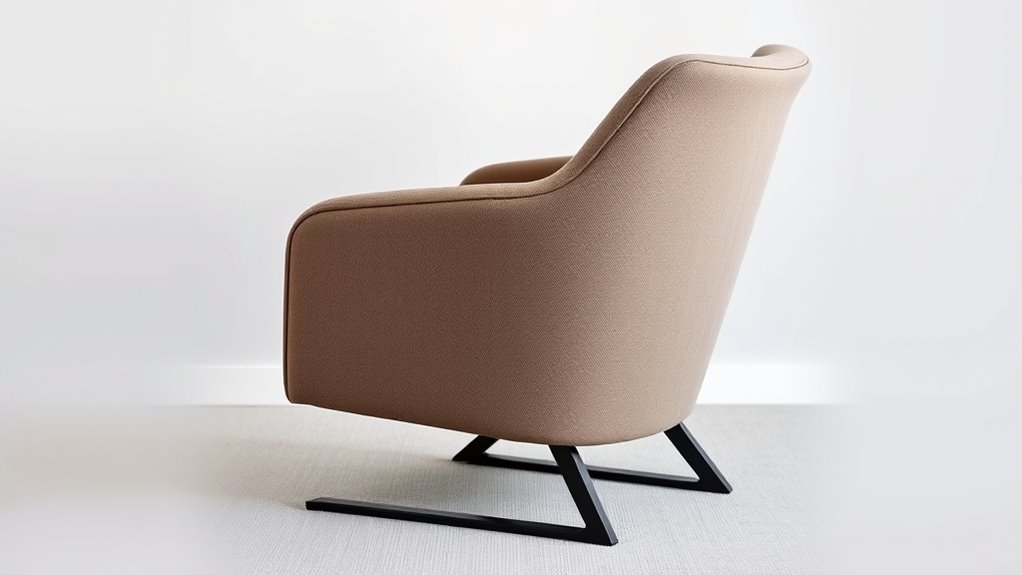
To make shifts from sitting to standing smoother, you can choose seating options specifically designed for easy movement. These chairs often feature flexible designs that promote effortless transitions. Look for seating with cushioning materials that provide comfort without compromising support, enabling you to rise easily. Aesthetic design also matters, as it guarantees the chair fits seamlessly into your space while remaining functional. Consider options such as lift chairs, which gently assist you in standing, or stools with adjustable heights that accommodate your needs. Incorporating protective styling benefits into your seating choices can also help maintain your hair health while facilitating movement.
Materials and Construction for Enhanced Support
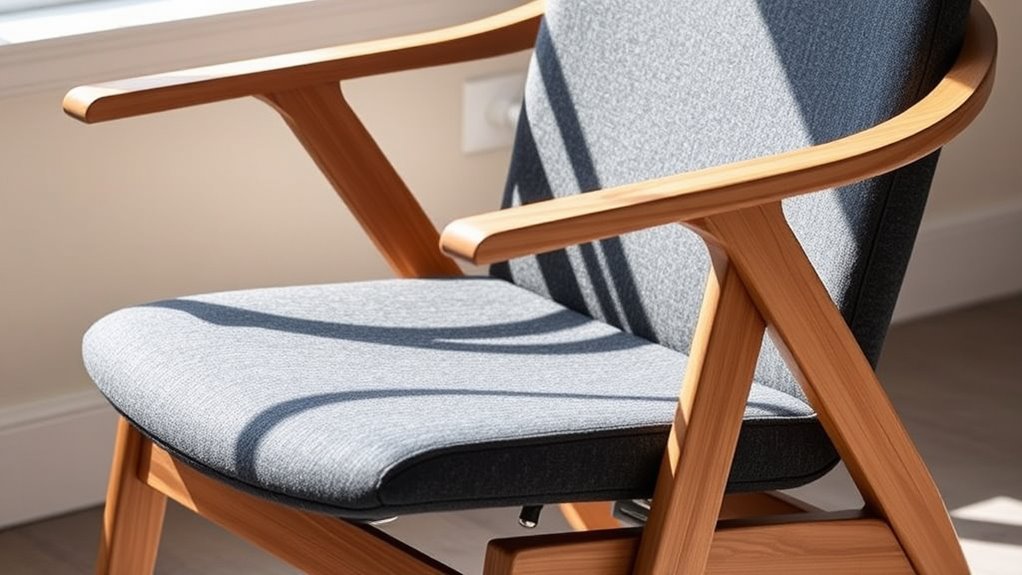
Choosing the right materials and construction for your seating can substantially improve support and durability. Focus on cushion comfort by selecting high-density foam or memory foam, which provides firm yet comfortable support, making standing up easier. Fabric durability is equally important; opt for tightly woven upholstery fabrics like nylon, polyester, or treated natural fibers that resist wear and tear over time. Reinforced frames made from sturdy materials like steel or hardwood ensure long-lasting stability, reducing sagging and maintaining support. Proper construction techniques, such as secure stitching and quality joins, prevent early deterioration. Additionally, understanding the self-watering planters mechanism can inspire innovative support features in furniture design. By combining durable fabrics with solid construction, your seating not only supports easy transitions but also withstands daily use, offering reliable comfort and stability for years to come.
Adjustable and Customizable Seating Options
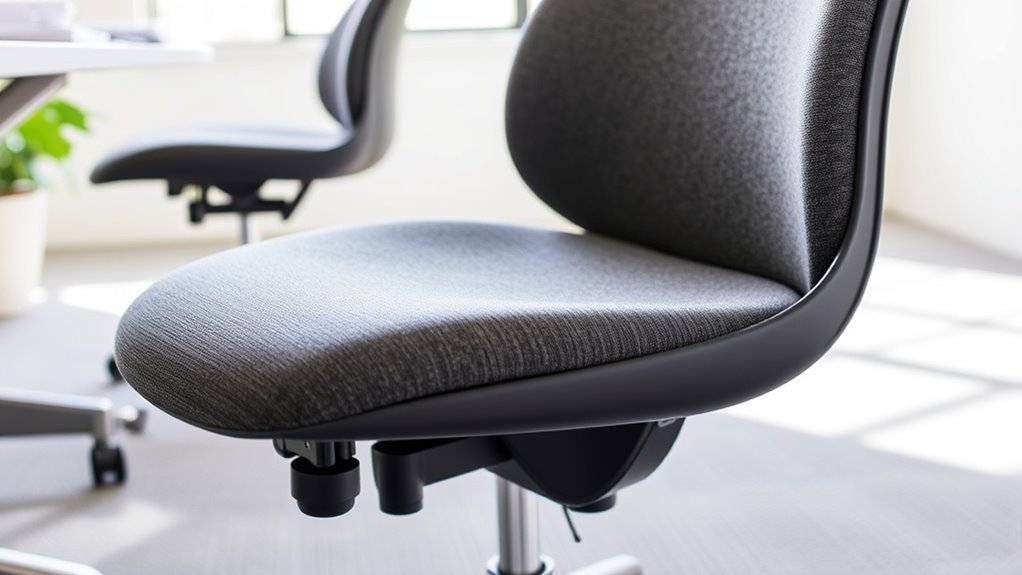
Adjustable and customizable seating options empower you to tailor your chair to your unique comfort and support needs. You can modify features like height, tilt, and lumbar support to make sitting and standing easier. Many chairs offer various color options, allowing you to match your environment or personal style. When taking into account options, keep in mind pricing considerations, as higher customization often comes with increased costs. Incorporating efficient coding practices can help in designing ergonomic furniture features that adapt seamlessly to user preferences. These options help you create a supportive, comfortable seat that enhances your mobility and reduces strain.
Tips for Choosing the Right Supportive Seat
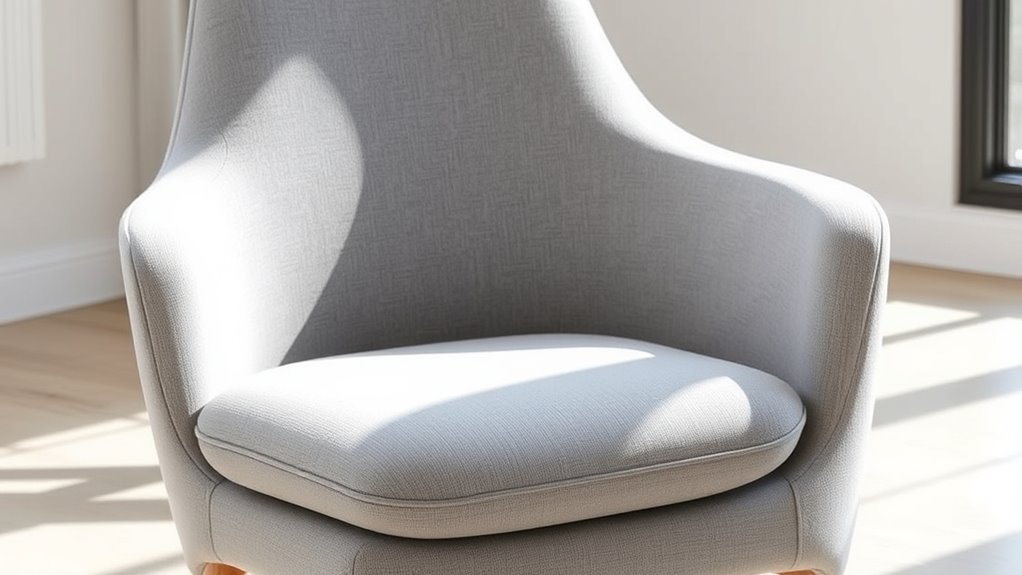
Selecting the right supportive seat involves considering how well the chair meets your specific needs for comfort, mobility, and ease of standing. Focus on cushion comfort to reduce pressure points and make sitting more enjoyable. Aesthetic appeal matters too, ensuring the chair complements your environment. Look for features like adjustable height and armrests, which make standing easier. To visualize options, consider this table:
| Feature | Benefit |
|---|---|
| Thick cushions | Enhance cushion comfort, reduce fatigue |
| Sleek design | Improve aesthetic appeal, boost confidence |
Prioritize a supportive seat that balances comfort and style, making it easier for you to stand up effortlessly and stay comfortable throughout the day. Incorporating sound vibrations has been shown to enhance cellular regeneration and overall health, which can contribute to your overall well-being and comfort in daily activities.
Frequently Asked Questions
How Do Supportive Seats Impact Long-Term Posture Health?
Supportive seats positively impact your long-term posture health by promoting posture correction and encouraging proper alignment. With ergonomic design, these chairs reduce strain on your back and neck, preventing discomfort and long-term issues. They help you sit correctly, making it easier to stand up and move around. Over time, this consistent support fosters healthy habits, reduces pain, and maintains your overall posture health, ensuring you stay comfortable and injury-free.
Are There Specific Seating Options for Individuals With Mobility Challenges?
Yes, there are specific seating options for individuals with mobility challenges. You might find ergonomic cushions helpful, as they provide extra support and improve comfort. Adjustable armrests are also essential, allowing you to modify your seat for easier transfers and better posture. These features work together to enhance safety and independence, making daily movements smoother and reducing strain. Always choose seating that adapts to your needs for maximum support.
How Does Seat Height Influence Ease of Standing Up?
Seat height directly impacts how easily you can stand up. An ergonomic design with a higher seat makes it simpler, reducing the effort needed. Choose a chair with adjustable height and a cushion with the right firmness—firm enough for support but soft enough for comfort. When the seat is at the right height, you’ll find standing up less strenuous, promoting independence and reducing strain on your muscles and joints.
What Maintenance Is Required for Supportive Seating Materials?
You need to keep supportive seating materials in top shape, balancing cleaning routines with durability. Regularly wipe down surfaces with gentle cleaners to prevent dirt buildup, but avoid harsh chemicals that can damage the material. Check for wear and tear, replacing components as needed to maintain support. Durable materials require minimal upkeep, but consistent care guarantees they stay supportive and comfortable, helping you stay active and safe during every sit-to-stand shift.
Can Supportive Seating Be Integrated Into Existing Workspace Setups?
Yes, you can integrate supportive seating into your existing workspace setups. To do so effectively, add ergonomic cushions for enhanced comfort and support, and adjustable armrests to accommodate different users’ needs. These features help promote easy stand-ups and improve overall ergonomics. You might need to rearrange some furniture or upgrade current chairs, but with the right accessories, integration is straightforward and can considerably boost comfort and productivity.
Conclusion
Choosing the right seating isn’t just about comfort—it’s about creating a supportive, stylish space that encourages effortless standing. By focusing on flexible features, quality construction, and personalized adjustments, you’ll foster a functional environment that fosters freedom and ease. Remember, the perfect supportive seat seamlessly combines comfort with capability, making movement smooth and simple. So, select a seat that supports your stance, suits your style, and simplifies your daily shift with sophistication and support.
